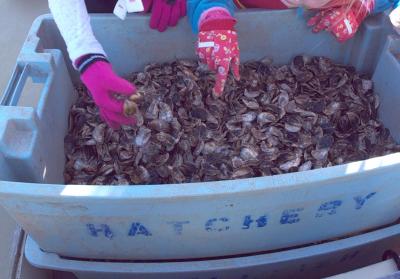Oyster Growing Program to Launch Soon

The director of the East Hampton Town Shellfish Hatchery has provided more details about the pilot program set to begin this spring in which residents will grow oysters in a 70-by-30-foot area in Three Mile Harbor in East Hampton.
At their meeting on Monday, Barley Dunne told the East Hampton Town Trustees, who have already approved the “community oyster garden” in the waters under their jurisdiction, that the project, modeled on Cornell Cooperative Extension’s Southold Projects in Aquaculture Training (SPAT) on the North Fork, would initially include 15 individuals or families. Only residents of the town are eligible, he said, and 12 or 13 applicants have already signed up.
The program, known as East Hampton Shellfish Education Enhancement Directive (EHSEED), will launch with a meet-and-greet at Bay Kitchen Bar, a restaurant on Three Mile Harbor, in May. On May 21, participants will attend a lecture on shellfish biology and brood stock conditioning at the hatchery, in Montauk. That event will include a slide show and walk-through of the facility, Mr. Dunne said. A second lecture at the hatchery, on how larvae and algae are cultured, is scheduled for June 25.
The oyster gardeners will meet on July 23 at the nursery site, where they will be given 1,000 seed oysters and the gear to grow them. Biweekly sessions in which participants will pull up their oyster bags and gear to manage the oysters’ growth and prevent fouling will follow, Mr. Dunne said. Another lecture, on proper handling of shellfish, will happen in September.
In mid-October, oyster gardeners, who will pay $250 to participate in the program, will give half of their oysters back to the hatchery, to be used to enhance its own seed production, and sink their gear to the bottom for the winter. In May 2017, it will be pulled back up and the growing procedure will resume.
The idea, Mr. Dunne told the trustees, “is to get people out there that are interested in growing shellfish. There seems to be a lot of them.” Participants, he said, will learn the importance of shellfish to waterways while simultaneously improving the ecosystem. A single adult oyster can filter up to 50 gallons of water a day, while the gear provides habitat for crabs, nursery fish, and other marine life. “Hopefully,” he said, “if the project goes well, ideally it will expand into other harbors and larger areas.”
“Start small and grow big,” said Tyler Armstrong, a trustee. “I’d like to see this get as big as possible.”
Mr. Dunne also proposed an oyster shell recycling program. Under the program, containers would be provided to restaurants in which their oyster shells would be put aside for regular pickup. The goal, he said, would be to return the shells to waterways after a six-month period spent outdoors to eliminate bacteria. He told the trustees that he planned to speak with Steven Lynch, the town’s highway superintendent, about a storage site at the town’s transfer station.
The purpose of the program, he said, was severalfold: Deploying shells on bottomlands, he said, promotes new growth and provides safe habitat for shellfish seed. “It’s been proven that clams do much better on the bottom where there’s some substrate,” he said. “When we seed, they fall in between the shells, and they survive better.” Returning shells to the water also returns calcium carbonate, which forms mollusk shells and hard corals.
Deborah Klughers, a former trustee, had been instrumental in establishing a scallop shell recycling program. That program, under which shells were brought to locations at Lazy Point in Amagansett and Boat Yard Road in East Hampton, drew complaints from the owners of the nearby East Hampton Marina about the strong odor at the latter location, from which they were removed. Mr. Lynch “was not happy about the scallop recycling,” said Diane McNally, a trustee
A discussion about incentives for restaurants’ participation followed, with Mr. Dunne telling the trustees that oyster shell recycling programs have been successfully implemented, with restaurant owners’ willing participation, in places including Nantucket.
